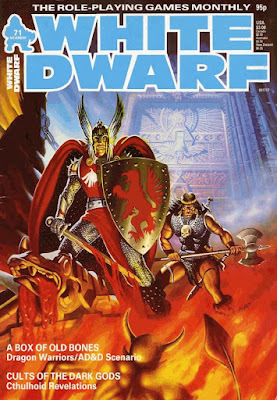White Dwarf: Issue #71
 Issue #71 of White Dwarf (November 1985) boasts an eye-catching Alan Craddock cover, featuring a team-up between a heroic knight and a Conan-esque barbarian, as they face off against a demonic horde. Meanwhile, Ian Livingstone's editorial focuses on the expansion of gaming conventions within the UK, which he suggests will result in "gamers up and down the country ... hav[ing] even greater opportunities to participate in their hobby, and meet famous personalities as well as other players." As someone whose own con experiences are quite limited, I'm fascinated by just how important conventions are, not simply to many gamers, but also to the history of the hobby itself. It's a pity I live in a wasteland when it comes to this sort of thing.
Issue #71 of White Dwarf (November 1985) boasts an eye-catching Alan Craddock cover, featuring a team-up between a heroic knight and a Conan-esque barbarian, as they face off against a demonic horde. Meanwhile, Ian Livingstone's editorial focuses on the expansion of gaming conventions within the UK, which he suggests will result in "gamers up and down the country ... hav[ing] even greater opportunities to participate in their hobby, and meet famous personalities as well as other players." As someone whose own con experiences are quite limited, I'm fascinated by just how important conventions are, not simply to many gamers, but also to the history of the hobby itself. It's a pity I live in a wasteland when it comes to this sort of thing.
Dave Langford's "Critical Mass" kicks off this issue. In addition to his usual reviews of books I've never read and, therefore, don't care about, he spends some time talking about "huge blockbusters arcing down from interliterary space." In reference to Larry Niven and Jerry Pournelle's Footfall, for example, he elucidates the flaws of blockbuster-style fiction, specifically "momentum takes 100 pages to build, several of the teeming characters are dispensable, and megadeaths are glossed over." These remain issues in this style of popular fiction even today, which is why I prefer short stories over 600-page doorstops.
"Open Box" reviews two gamebooks I've never encountered before: Avenger! and Assassin! (both 8 out of 10). Published by Knight Books, they take place in a world of "Kung Fu meets AD&D," with the viewpoint character being a ninja. The description of the books' unarmed combat system sounds genuinely interesting. Also reviewed is the Paranoia adventure, Vapors Don't Shout Back (7 out of 10), Masks of Nyarlathotep for Call of Cthulhu (9 out of 10), and Thrilling Locations for James Bond 007 (9 out of 10).
"The Face of Chaos" by Peter Vialls is yet another article discussing the contentious topic of alignment in Advanced Dungeons & Dragons. I must confess this topic bores me to tears, but, judging by the number of articles written about it over the years, I must be in the minority. In any event, Vialls rehearses all the usual beats – What is alignment anyway? How does Chaos differ from Law? Isn't Neutral a cop-out?, etc. – without offering any answers that are new or interesting. That's no knock against him, of course, just an acknowledgment that, after decades of debate, there's not much insight left to be gleaned, so why not write about something else?
"Not Waving But Drowning" by Dave Lucas presents RuneQuest stats for the fossergrim and nereid. "Cults of the Dark Gods" by A J Bradbury provides historical information on the Assassins and Knights Templar for use with Call of Cthulhu. However, Bradbury doesn't give either group any significant connection to the Mythos, which leaves me wondering about the actual purpose of the article. Fortunately, this month's installment of Thrud the Barbarian leaves no doubt as to its purpose, to wit:
 "A Box of Old Bones" by Dave Morris is a low-level adventure written for use with both AD&D and Dragon Warriors. Dual-use scenarios of this sort appeared regularly in the pages of White Dwarf and I have long wondered how often anyone made use of the "lesser" of the two game systems for which it was written. In any case, this scenario is a clever and original one that focuses on the theft of a saint's relics, hence its title. There's no magic or miracles here, only human greed, which I found refreshing – an excellent change of pace adventure.
"A Box of Old Bones" by Dave Morris is a low-level adventure written for use with both AD&D and Dragon Warriors. Dual-use scenarios of this sort appeared regularly in the pages of White Dwarf and I have long wondered how often anyone made use of the "lesser" of the two game systems for which it was written. In any case, this scenario is a clever and original one that focuses on the theft of a saint's relics, hence its title. There's no magic or miracles here, only human greed, which I found refreshing – an excellent change of pace adventure."Avionics Failure" by James Cooke discusses what happens when a Traveller starship suffers damage to its sensors, providing a random failure table to aid the referee in adjudicating the matter. It's not a sexy or groundbreaking article, but it looks useful for ongoing play and that's not nothing. The Travellers comic begins a new storyline, one based on the classic GDW adventure, Shadows. As always, there are lots of fun little bits in the comic. My favorite is the following:
 There's yet more Traveller content in this issue, in the form of Marcus L. Rowland's "Tower Trouble." This is a terrific adventure designed for high-skilled criminal characters who are planning a heist on Terra Tower, a beanstalk (as we'd call it today) stretching from Earth's equator to syncrhonous orbit. The scenario is well written, has great maps and referee's advice, and includes pre-generated characters with a lot of individuality. I'm half-tempted to try running sometime as a one-shot, because it looks like fun.
There's yet more Traveller content in this issue, in the form of Marcus L. Rowland's "Tower Trouble." This is a terrific adventure designed for high-skilled criminal characters who are planning a heist on Terra Tower, a beanstalk (as we'd call it today) stretching from Earth's equator to syncrhonous orbit. The scenario is well written, has great maps and referee's advice, and includes pre-generated characters with a lot of individuality. I'm half-tempted to try running sometime as a one-shot, because it looks like fun."Monsters Have Feelings Too Two" by Olive MacDonald is a follow-up to an article originally appearing in issue #38. This time, MacDonald wants to emphasize that intelligent monsters shouldn't be one-trick ponies. They can (and should) be used in a variety of different ways within a campaign. This is why MacDonald uses only a sub-set of the monsters available in any given game he referees, since he finds it more interesting to make those he does use multifaceted. I find this hard to argue with and have long argued that games like D&D probably have too many monsters. "Just Good Fiends" by Ian Marsh looks at a related question: what makes a good monster? While Marsh isn't opposed to the idea of introducing new monsters into a game, he does think that every monster should serve a purpose or fill a niche within a game or campaign setting. This is a solid, thoughtful article on a topic that has long been of interest to me.
"Divine Guidance" presents two new oracular magic items for use with Dungeons & Dragons: the Card of Shukeli and Tellstones. The former is a kind of prophetic Tarot card whose face changes based on the imminent fortune of the person who finds it, while latter are paired stones whose temperatures change based on how close they are to one another ("getting warmer ..."). Joe Dever's "Think Ink," in which he talks about a topic of which I knew nothing: the use of drawing inks to tint painted miniatures. Dever's articles never cease to amaze me with the technical knowledge they impart. It's a reminder (yet again) that I know nothing about miniatures painting. Finally, "Gobbledigook" gets a full page to this month's episode, in which we see graphic evidence that "Goblinz never fight fair!"

James Maliszewski's Blog
- James Maliszewski's profile
- 3 followers



